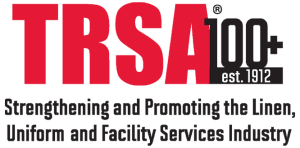TRSA Rejects Misreading of Hygienically Clean
A recent news release from the Association for Linen Management portrays a “U.S. testing program” (a thinly veiled reference to TRSA’s Hygienically Clean Healthcare certification) as relying on regular microbiological testing of clean textiles to determine whether laundry practices place them at risk for contributing to hospital-acquired infections. In fact, the Hygienically Clean standard contains rigorous protocols for quality assurance (QA), requiring inspection for initial certification and re-inspection to maintain it.
 ALM fails to clearly identify Hygienically Clean and note its QA protocols in the Jan. 19 release, which quotes a June 2015 Infection Control & Hospital Epidemiology article by Lynne Sehulster, PhD, M (ASCP). The release does not mention her service as a member of the Healthcare Laundry Accreditation Council (HLAC), the organization TRSA initiated in 2005 to introduce laundry certification to the healthcare industry.
ALM fails to clearly identify Hygienically Clean and note its QA protocols in the Jan. 19 release, which quotes a June 2015 Infection Control & Hospital Epidemiology article by Lynne Sehulster, PhD, M (ASCP). The release does not mention her service as a member of the Healthcare Laundry Accreditation Council (HLAC), the organization TRSA initiated in 2005 to introduce laundry certification to the healthcare industry.
Dr. Sehulster states in her article that the “U.S. program” testing protocol doesn’t provide a “meaningful representative sample of HCT (healthcare textile) output” between laundry inspections. “The testing requirement was never intended to meet this criterion; the TRSA program is not based on testing to verify that laundry practices encompass applicable infection control guidelines,” explained Joseph Ricci, TRSA president and CEO.
“Hygienically Clean inspections verify laundry processes; microbial testing quantifies cleanliness, providing a vital adjunct to ensuring that best management practices (BMPs) are documented and followed for the production of hygienically clean textiles,” he added. Between inspections, testing indicates changes in laundry processing techniques, particularly wash chemical adjustments.
TRSA introduced Hygienically Clean in 2012 to preserve the core of HLAC certification while enhancing the certification with the testing component. Microbiological testing has been conducted in Europe and Australia for 30 years, but to date, Hygienically Clean is the only known U.S. healthcare laundry certification to require it. Promoting Hygienically Clean has emphasized this component to highlight the contrast, overshadowing the new certification’s dedication to verifying that plant facilities, housekeeping and laundry processes meet the program standard.
Why has it taken so long for microbial testing to win acceptance here?
- Clean textile products rarely have been implicated in HAIs.
- As Dr. Sehulster indicated in her article, in addition to laundry malfunction, poor storage condition of HCTs after laundering can be responsible for inadvertent contamination.
- As a 2013 Robert Wood Johnson Foundation/Urban Institute report concluded, the healthcare industry has traditionally been more focused on measuring structures and processes than outcomes (Hygienically Clean measures all).
In two recent high-profile cases linking to fatal HAIs (New Orleans Children’s Hospital, 2008; Queen Mary Hospital, Hong Kong, 2015), laundry practices were implicated. “We can only speculate whether microbial testing would have confirmed these deficiencies,” Ricci posits. “But we can be sure that it is well worth the time, effort and cost of implementing the Hygienically Clean protocol everywhere if one failed test prompts changes in laundry practices that save one life.”
The ALM release indicates that a follow-up investigation by Dr. Vincent Cheng at Queen Mary Hospital cited “microbiological testing as a solution” for issues with the hospital’s laundry supplier, such as separating clean and soiled linen, proper storage at the laundry and machinery maintenance.
“Hygienically Clean addresses these matters through its inspection component,” Ricci added. “They would be uncovered by examining a facility’s QA documentation and the evidence that BMPs are being implemented.”
